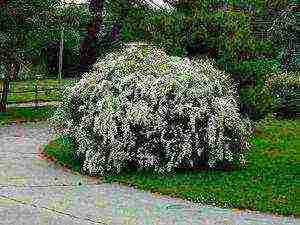Content [show]
Some garden crops are grown for more than just the harvest. Planting beans on the site will help solve several problems at the same time. They will provide the family with healthy vegetables with a rich composition and high nutritional value, enrich the soil with nitrogen and make it looser. Their highly branched roots, forming real dense thickets under the ground, interfere with the development of weeds and reliably protect the surface fertile soil layer from being washed out by rains. Black Russian beans are surprisingly unpretentious and require almost no maintenance. Within 2 months after planting, each plant will bear 6-16 fruits, which can be cooked without resorting to peeling.
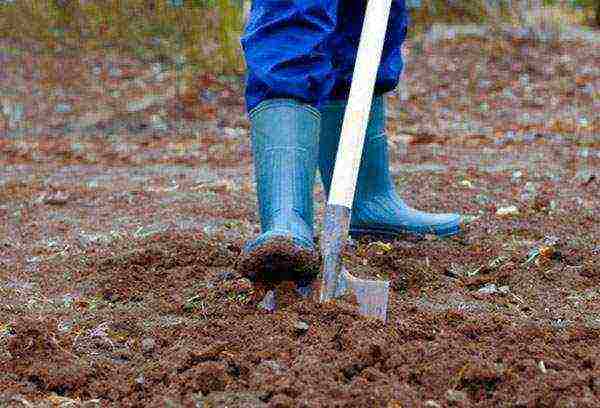
Site requirements
The beans will demonstrate the highest yield on fertile loose loamy soils, which are characterized by a neutral or slightly alkaline reaction. But even in a soil poor in nutrients, they can successfully grow and bear fruit. For full development, beans need potassium. If this element is not enough in the ground, you will have to artificially introduce it before planting. Professionals advise fertilizing the beds with wood ash or organic compounds.
Plants will need a lot of light, so you need to choose the sunniest area for them in the garden. Cold and too wet sandy ground is absolutely not suitable for beans. The seeds sown in it most likely will not germinate, but will simply rot. An ideal place for plants is a small hill, which is well warmed by the sun, freed from snow early and from which water flows down during heavy rains.
Beans react poorly to an excess of nitrogen in the soil. Observance of crop rotation is very important for this crop. You cannot make beds for plants in areas where their relatives by family were located last season: beans, peas, soybeans, chickpeas, lentils, peanuts. The soil suits them after growing the following crops:
- potatoes;
- tomatoes;
- cucumbers;
- pumpkins;
- cabbage.
But in the place vacated after their harvesting, all crops will develop well, except for legumes.

Landing dates
The beans are propagated by seeds.They are large in size, so there is no need to thoroughly prepare the soil for planting them. They can be sown in open ground already at the beginning of April, when the snow melts from the site and the earth dries up slightly. They are not afraid of spring frosts: the planting material can easily withstand temperatures as low as -4 ° C. In order for the seeds to germinate together, the soil must be warmed up to at least 5 ° C.
In regions with cold climates, it is practiced to grow beans through seedlings. In this case, they are sown in separate containers. The procedure is carried out 30-35 days before the planned date of planting plants in the beds (usually this is mid-May). This method is also used when you want to eat the harvest faster. Before placing the seedlings on a permanent site, they are hardened.
Advice
If you plant the seeds in stages, every month, properly caring for the sprouts, you can harvest the beans from the beans until the fall.
Sowing is carried out in 2 ways:
- on a flat area, leaving 40 cm of free space between the seeds;
- on the beds, reducing the distance between adjacent beans to 20-25 cm for dwarf varieties and up to 10-12 cm for tall ones.
The row spacings are made wide - at least 45 cm. Most often, the beans are planted in 2 rows. This way the plants will bear more fruit and it will be easier to care for them. If black Russian beans are chosen for breeding, the row spacing is reduced to 30 cm, and the seeds are laid out with a small interval - about 3-5 cm. It is better to plant them down with a scar: this way the seedlings will appear faster.
Sowing is carried out in moist soil. It will not be superfluous to water the beds after it ends. The planting material is preliminarily prepared by placing the seeds in water (for 5-6 hours) or in a growth stimulator (for 2-4 hours). You can wet a piece of cloth and wrap them in it so that they hatch. The depth to which the beans are buried depends on the quality of the soil. If it is light, the seed hole is made 6-7 centimeters long. If it is heavy, 3-5 cm will be enough. Having dug in the seeds, mulch the surface of the garden. It will take 14 to 20 days for the young beans to emerge from the ground. After that, the main task is to provide competent care for the plantings.
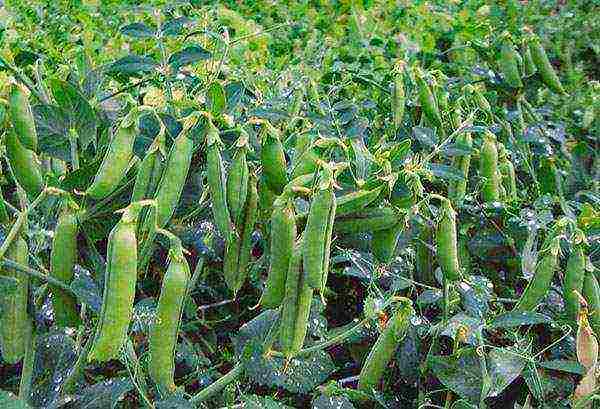
Subtleties of agricultural technology
Outdoors, the beans don't have to pay much attention. They belong to drought-resistant crops, but if it has not rained for a long time, the plantings need to be watered. They do this twice a week, spending at least 10 liters of water per square meter. It is very important to regularly carry out care in the form of moisturizing at the stage of budding, flowering and ovary formation. Lack of water during this period will significantly reduce the yield of plants. Their flowers will begin to wither and fall off, the same fate may befall the already formed pods.
Excess moisture is also harmful to beans, especially in the early stages of their development. Seedlings will actively increase the green mass, but they will not please with abundant flowering. Fruits on plants are set at a temperature of 20-22 ° C. In hotter weather, when the air heats up to 25 ° C and above, you may not expect a good harvest. Frequent feeding of the beans is not required. At the germination stage, they are fed with mullein (0.5 l) and urea (1 tbsp. L).
Both fertilizers are thoroughly mixed in 10 liters of water. The resulting solution is poured over the plantings, spending 0.5 liters of the nutrient mixture for each bush. Further care includes feeding with herbal infusion diluted 1:10 or 1:15. It is carried out once a season, choosing the time after weeding for the procedure.
Tall beans are tied up to make it easier to care for them. The easiest way is to install a trellis for them. They do it like this:
- after planting, support stakes are driven into the soil at the edges of the rows. Their height should be 1-1.2 m;
- when the seedlings grow a little, a wire is pulled on the stakes with an interval of 30 cm.

Growing secrets
To grow beans more successful, regular soil loosening is carried out. In the spring, while the seedlings are still small, it is recommended to spud them with a hoe.The culture does not like the neighborhood of weeds, so the beds must be kept clean.
When the plants are covered with flowers, the upper part of their stems is pinched, shortening by 10-15 cm. The tender and juicy shoots lure the black bean aphid, for which they are a favorite delicacy. Getting rid of this pest will not be easy. Pinching also affects the ripening of the fruit, making it more even.
The first crop of beans outdoors can be harvested in early summer. It is important not to be late with the dates, otherwise the fruits will overripe, becoming slightly edible - fibrous and tough. You can eat beans of milk ripeness, which have reached a length of 10-15 cm. In fully finished fruits, seeds are visible through the valves. First of all, the lower beans are removed from the bush, and the rest are harvested as they ripen. If the leaves are already blackened, it is best to leave the fruit on the plant so that you can later get seeds from it for planting.
Black Russian beans have a long history of cultivation. They were an important part of the diet of our ancestors, who appreciated this vegetable crop for its simplicity of agricultural technology and health benefits. When eating bean dishes, the feeling of satiety remains for a long time, they saturate the body with the vitamins, minerals and trace elements it needs. They are also used in folk medicine, providing anti-inflammatory, astringent and diuretic effects.
Plants are not afraid of heat and cold, and the presence of a powerful root system and a massive stem does not allow them to break under the weight of the crop or strong wind. Beans are the perfect fertilizer. Throughout their life cycle, they will enrich the soil with nitrogen. And when it is completed, the bushes can be pulled out of the ground and buried during the autumn work on the site. The stem and leaves of the beans will quickly decompose, saturating the soil with nutrients.
Since the time of ancient Russia, the main vegetable crop among the Slavic peoples was considered beans... As part of legumes cultures contain ingredients unique to the human body: more than 30% proteins, 15% light fats, mineral salts, trace elements. Beans easily assimilated in any form: young, not yet ripe and mature.
Interesting! In terms of energy value, beans have advantages over other vegetables. Their caloric content is 3 times higher than that of potatoes, 7 times higher than that of cabbage, 6 times higher than that of corn.
Both green, unripe fruits and dry, at the stage of biological maturity, are useful for the children's diet. Dense, hard require heat treatment for food use: boiling or stewing.
Growing beans as siderates, is becoming a common way. They are used for soil restoration, enrichment with trace elements and minerals. Nodule microorganisms of the root system assimilate nitrogen from the air, synthesizing ammonia forms. Organic plant residues decompose, loosening the soil, and the roots form clumps, which prevents soil leaching and prevents weed growth.
Description of culture
Beans - an annual vegetable crop with a developed root, up to 100 - 150 cm long. The stem is erect, tetrahedral, weakly branching.
Plants are divided into two categories: short and tall, with a height of 30 to 140 cm. Early varieties have a short ripening period. Compound leaves consist of 3 - 5 leaflets, with a stipule ending in a tip.
Inflorescences of 5 - 6 white flowers. Sometimes - with a black spot on the wings. There are varieties with different shades: yellow, brown, blue and variegated.
Have beans - long, sometimes curved fruits, depending on the variety, from 4 to 20 cm long, as well as two thick valves, which are green at the stage of technical maturity, but become dark, with a dense skin at the biological stage of maturation. In some varieties, the walls have a pronounced parchment layer. When fully ripe, they do not crack or spill out. In other varieties, such a layer is insignificant or absent.
Seeds for growing legumes are selected according to technical characteristics. They differ in shape, size and color. Color palette - from white to black. There are green, brown, black, mixed colors of fruits. Share beans into two types: fodder (small-seeded) and vegetable, large-fruited.
Reference! Beans are a plant of long daylight hours, undemanding to temperature conditions, germinate at a temperature of 2 - 3 degrees Celsius. Resistant to minor, up to -4, frosts. Under favorable weather conditions, seedlings appear 10-17 days after sowing. The optimum air temperature for flowering is from 15 to 20 degrees Celsius.
Moisture-loving plants require regular and abundant watering, they do not tolerate even a short drought. They need to be watered at least 2 times a week. For the fruits to swell and germinate, moisture is needed from 100 to 120% of their mass.
Beans have a long shelf life. In favorable conditions, they do not lose their taste for many years. Germination seed for growing beans lasts up to 10 - 11 years.
Plants are self-pollinating. In rare cases, cross-pollination is possible. The growing season is 80 to 140 days.
The best varieties of beans
On the territory of Russia, several garden varieties of beans have been acclimatized and gained wide popularity.
 Velena
Velena
Unpretentious in care, soil quality. Seeds are rounded-angular, light fawn in color. Fruits are medium, curved, green in color with sparse pubescence.
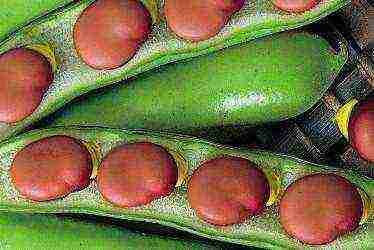 Belorussian
Belorussian
The fruits are large, straight, up to 10 cm long. The grains are light brown, oval in shape.
Virovsky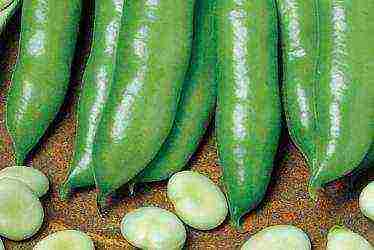
Cold-resistant grade. The plant has 24 - 26 beans with excellent taste.
Aushra
Resistant to cracking, drought, not affected by pests.
 Black Russian
Black Russian
Has a short ripening period, bears fruit stably. The fruits are eaten green and ripe.
Black giant
Tall variety, with large fruits up to 14 cm.
Windsor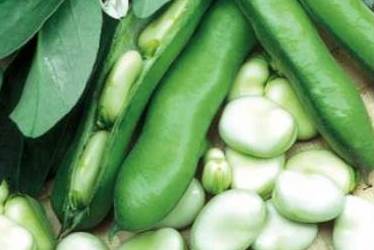
An early ripe variety, with increased productivity, frost-resistant. The fruits are large, with white or green seeds.
The most suitable soils for growing beans from seeds - loamy, with good sunlight. The acidity index of the soil should not exceed 7.0. The introduction of wood ash and organic fertilizers increases yields, accelerates growth legumes cultures. It is better to place landings on elevated terrain.
Plants, independently providing the soil with nitrogen, do not tolerate its excess, they do not tolerate a lack of potassium. Therefore, planting after crops of the family is not recommended. legumes.
Reference! The best precursors to beans are tomatoes, all types of cabbage, cucumbers and potatoes.
Planting beans
Preparing the soil for planting
By planning growing beans, choose a suitable site for the future harvest. The garden bed is dug up from autumn to the depth of the arable layer, organic fertilizers are applied at the rate of 1 sq. M - 3-4 kg. Ash (30-60 g per 1 sq. M.) Reduces the acidity of the soil, promotes the activation of nodule bacteria. With the onset of heat, the site is dug up again, 10-20 g of superphosphate, 20 g of potassium salt are added. In areas with depleted soil, add 10 g of ammonium nitrate per 1 sq. m.
Fertilizers
Fertilization is a prerequisite for obtaining a full crop of beans. From autumn, before the onset of cold weather, compost, pig or cow manure, humus are introduced into the soil and dug up. It is not recommended to use poultry manure due to its nitrogen content. For enrichment, phosphorus fertilizers are required. When digging, superphosphate is added to the ground.
Advice! For full-fledged growth, abundant fruiting of beans, organic fertilizers are important. Even fresh manure is used, which is brought in during digging (plowing) per 1 sq. M up to 2-3 kg.
Beans easily assimilate phosphorus fertilizers. It is recommended to add phosphate rock from autumn, per 1 sq. M up to 50-60 g.A popular way to add it when laying compost. In the process of composting, 15-20 kg are added to 1 ton of manure and plant waste.
Mineral fertilizers for the site under growing beans make before cultivation (digging): 30-40 g of superphosphate, 10 g of boron-magnesium fertilizers per 1 sq. m.
Trace elements ensure the growth of green mass and high yields. For processing before sowing, micronutrient fertilizers are used. Their combination with pesticides (herbicides, fungicides) and dressing is possible seed... Copper fertilizers show good results on soils with insufficient copper content, marsh and sandy soils. Treatment with a solution of copper sulfate (0.1 g of copper sulfate per 1 kg of beans) is recommended. Lime is added to the soil with high acidity.
Seed preparation for sowing
Preparing seeds for sowing, they are sorted and checked for germination, deformed grains damaged by pests are removed. The soaking procedure is optional. If soaked, then for a period not exceeding 15 hours. Prolonged soaking reduces germination.
Healthy! For disinfection, you can hold the beans for a couple of minutes in hot water, with a temperature of up to 50 degrees, then dry them and treat them with growth stimulants.
Sowing seeds
Sow beans early spring, the timing depends on regional characteristics and temperature indicators. At growing legumes in the central regions of Russia, sowing begins from the end of April, and in the north - from mid-May. This is due to the plant's frost resistance (up to -4 degrees), the need for moisture. Planting at a later date negatively affects germination, seeds germinate unevenly, and are also more exposed to pests and diseases.
With single-row plantings, leave the distance between plants 40-60 cm. In double rows - 20 cm, between a pair of rows - 50 cm. The distance between the bushes should be at least 12-15 cm. After planting the seeds, the soil is abundantly watered and "rolled" with a special device, cover from rooks.
Can grow legumes in separate areas or combine with other vegetable crops. In this case, the likelihood of aphid damage is reduced.
The seeding rate of seeds is 23-35 g per 1 sq. M, the seeding depth is 6-8 cm. Surface sowing leads to lodging of bushes.
Under favorable conditions, seedlings appear in 2-3 weeks. Agricultural technology for them consists in regular weeding and loosening. Intensive fruit setting is possible at an air temperature of 20-22 degrees. In hot weather, at more than + 25 ° C, barren flowers will form.
Watch the video! Planting beans
Crop care
In dry weather, after sowing, roll up the soil and harrow after 3-4 days to stop the growth of weeds, and no crust forms on the surface.
When shoots appear, the harrowing procedure is repeated 2-3 times: immediately after the formation of 2-3 leaves and 5-7 days after that. It is necessary to harrow across the rows with seedlings. It is better to carry out the procedure in the afternoon, when the plants are less fragile.
For the entire period growing beans the soil is loosened 2-3 times between the rows. The first time it is processed to a depth of 10-12 cm, the second time - by 6-8 cm. With each loosening, the soil around the bush is slightly spud.
It's important to know! To get a good harvest, beans need abundant regular watering and feeding.
Plants are fed during the period of the first and second treatments. On a plot of 1 sq. m it is necessary to add 10 g of superphosphate, 5 g of potassium salt, 5 g of ammonium nitrate. For maximum effect, liquid fertilizing is carried out. In such cases, add 3 g of fertilizer to 1 liter of water. After sowing, watered abundantly.
When setting the fruits, the tops of the plants are pinched, which accelerates their growth and increases their size. The procedure is necessary to prevent damage to aphids, which form colonies in the upper parts of the bush.
Harvest
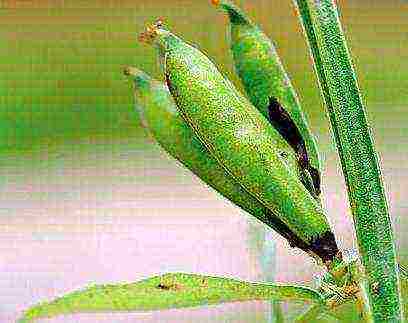 Harvested depending on the purpose of use.Young green fruits for use with valves are harvested when they are still unripe and soft, with seeds no more than 1 cm. In this phase of ripening, they are especially tender and tasty. When beans reach a standard size, the flaps are no longer suitable for use.
Harvested depending on the purpose of use.Young green fruits for use with valves are harvested when they are still unripe and soft, with seeds no more than 1 cm. In this phase of ripening, they are especially tender and tasty. When beans reach a standard size, the flaps are no longer suitable for use.
At growing beans it is worth considering the growing season. Cleaning is carried out in 3-4 receptions, every 8-10 days. The fruits are carefully broken off with your hands so as not to damage the bush. If the seeds are planned to be left for a future harvest, they are harvested when the leaves become hard, black in color.
After cleaning beans sorted by selecting suitable, large, regular shape and appropriate size. To determine the germination of fruits, they are placed in a solution of table salt and empty ones float to the surface. For the prevention of pest control, plants are treated with "Granazol" or "TMTD" a few weeks before the projected sowing. On the day of planting, the beans are etched with Nitrogin.
The benefits of beans for the garden
The need to grow beans on the site is due to the fact that they:
- enrich the soil with nitrogen (there is no need to use artificial fertilizers);
- reliably protect vegetable crops by releasing phytoncides that suppress the growth of pathogenic bacteria, infections, fungal diseases;
- improve the structure and quality of the soil;
- scare off moles, malicious pests of vegetables and berry crops;
- restore soil after vegetation when used together with mustard, rye, lupine.
Beans - a versatile healthy product that is used to prepare a variety of dishes. They also enrich the soil. Growing beans does not require special skills and technologies. Be sure to plant them on your property and they will become indispensable crops in your vegetable arsenal!
Watch the video! Bean harvest
Beans are an excellent crop with a high content of beneficial micronutrients, proteins and a pleasant taste that gives a feeling of fullness. As an “energy drink for nutrition,” beans are 3 times more caloric than potatoes and 7 times more than cabbage. It is very useful for children to eat both young unripe beans (raw) and completely ripe, dried up. Due to their high-quality hardness, they already need to be boiled or stewed.
Beans are not picky about their predecessors in the garden, like soybeans or peas, but after them, in the next season, any vegetables and plants (except legumes) grow well. But at the same time, like any other vegetable crop, in the process of their growth, they need timely and proper care, proper planting. But how all this can be done, we will describe in detail in this article.
Site requirements
Beans can demonstrate higher yields on fertile loose loamy soils, with a neutral or slightly alkaline reaction. But they can also grow and bear fruit successfully in nutrient-poor soil.
For full development, they also need potassium, and in cases where this element is still not enough in the ground, then it will have to be artificially introduced before planting. Experienced gardeners recommend fertilizing the beds with wood ash or organic compounds.
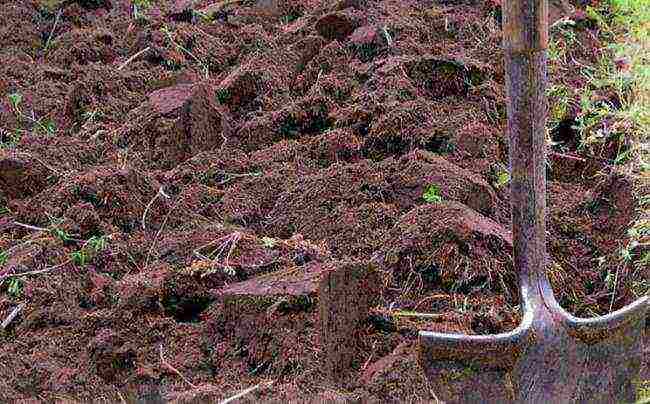
Plants also need a lot of light, and therefore, whenever possible, we plant in a sunny area of the garden. It is not recommended to plant them in cold and too wet sandy soil, since the seeds sown in it will not only not sprout, but will simply rot.
The ideal place for growing beans is a small hill, warmed by the sun's rays, freed from snow early, and from which water will drain during heavy rains.
Beans react badly to an excess of nitrogen in the soil.
A fairly important condition for this culture is also the observance of crop rotation. That is, in the area where relatives in the family were grown last season (peas, beans, chickpeas, soybeans, peanuts, lentils), beans cannot be planted.
A site is suitable for them, where the predecessors were crops such as potatoes, tomatoes, cucumbers, pumpkin, cabbage. But after the beans, it will be possible to grow almost all types of crops, except for legumes.
When to plant beans?
To germinate the beans, 2-5 ° C heat is enough. Spring frosts are not terrible for them, since the planting material is able to withstand temperatures up to - 4 degrees.
Therefore, it will be possible to start sowing as soon as the soil starts to warm up. But for friendly seedlings, the soil must be warmed up to at least 5 degrees Celsius. In most regions, sowing of this culture is carried out from the end of April to the second decade of May.
The beans will feel as comfortable as possible at a temperature of 20-22 ° C. But at temperatures above 25 ° C, they will already suffer: the set flowers fall off and the fruits do not ripen.
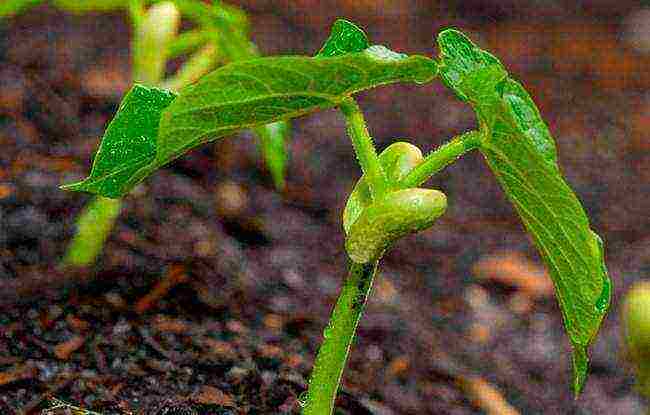
In regions with cold climates, it is practiced to grow beans through seedlings. In this case, sowing should be carried out in separate containers, which must be done 30 - 35 days before planting plants on the beds, but before planting in a permanent place, the seedlings are still hardened. As a rule, this method is used to obtain an early harvest.
Sowing
Before planting, the seeds are placed in water for about 5-6 hours or in a growth stimulator for 2-4 hours. To hatch, you can wet a piece of cloth and wrap them in it. If the seeds are very dry, they need more time to soak - it is better to leave them for 12-20 hours, changing the water periodically.
Sowing seeds can be done in two ways:
- On a flat area, leaving 40 cm of free space between the seeds;
- On the beds, reducing the distance between adjacent beans to 20 - 25 cm for dwarf varieties and up to 10 - 12 cm for tall ones;
The row spacing should be at least 45 cm. The planting itself, as a rule, is carried out in two rows, which is due to the fact that in this way the plants will bear more fruits, and it will be easier to care for them.
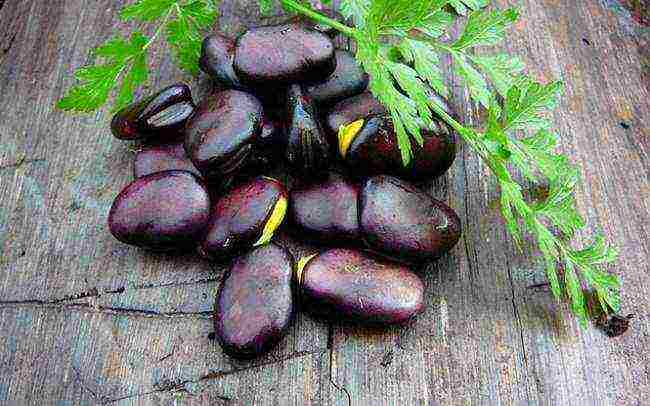
In cases where black Russian beans are used for planting, the row spacing is reduced to 30 cm, and the seeds are laid out with a small interval - about 3-5 cm. Sowing is carried out in moist soil. It will not be superfluous to water the beds after it ends.
The seeding depth depends on the quality of the soil. On light soils, the depth of the hole for the seed is 6-7 cm, on heavy soils - 3-5 cm. Having dug in the seeds, we mulch the surface of the bed. Seedlings will appear in about 14-20 days. After that, the main task will be to properly care for the plants.
Care
Watering... The beans can withstand long enough without watering, but at the beginning of the growth, a lot of water is needed. In cases where there has been no rain for a long time, then the planting must be watered. As a rule, it is watered 2 times a week, at the rate of at least 10 liters of water per 1 sq. meter.
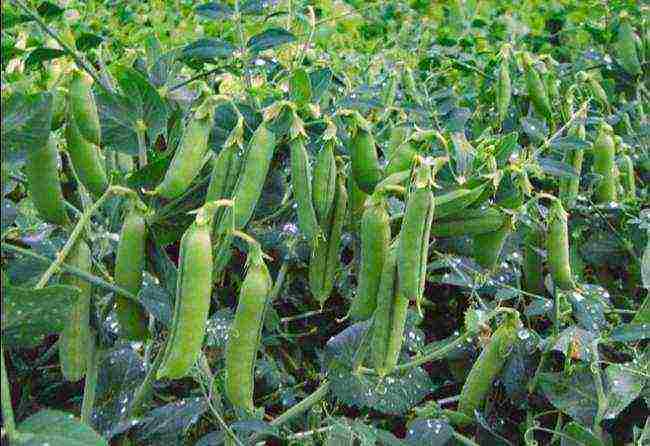
Loosening... The land around the plants must be periodically loosened and weeds removed. Row spacings are processed several times to a depth of 8-12 cm; the first loosening is carried out after the appearance of the second leaf, then they are repeated as the soil crust is formed and stopped at a plant height of 50-60 cm.
At the second and third loosening, the plants are spud, which helps to strengthen the root system, increase the resistance of plants to winds.
Top dressing... If the plants grow slowly, they are fed with potash and nitrogen fertilizers - 10-15 g per square meter. m.
Garter... Only tall varieties need a garter (to facilitate the process of caring for them).
To do this, we install a trellis on them, which can be done as follows:
- After planting, we drive stakes into the soil along the edges of the rows - supports (height 1-1.2 m);
- When the seedlings grow a little, we pull the wire on the stakes with an interval of 30 cm;
Collection and storage
They start to remove the beans when the seeds in them are almost completely developed, but they have not yet lost their tenderness and "black grooves" have not formed at the place of attachment to the fruit.First of all, we remove those fruits that are located at the bottom of the stem. We break them out, free the seeds from the valves.
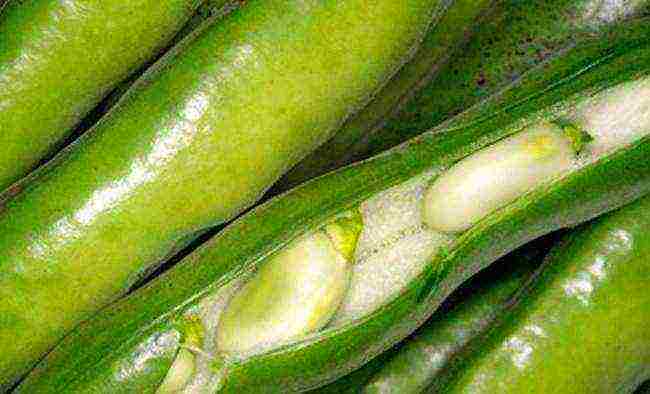
In cases where the fruits will be used as a whole (grains with valves), we remove them when the valves are still juicy, and the grain size reaches about 1 cm.In cases where the grown grains will be eaten raw, the beans should be harvested when the seeds in milk ripeness, they reach the full size for the given variety.
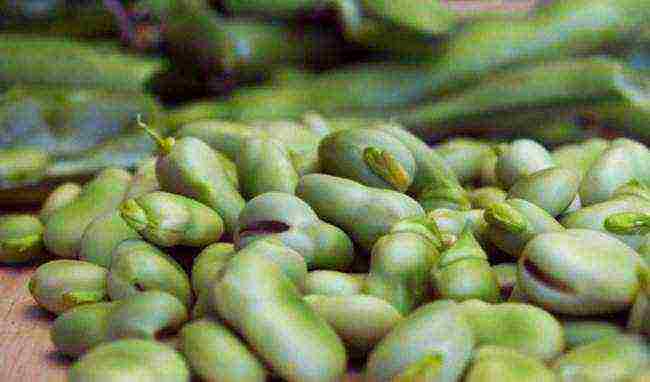
We harvest the crop in 3-4 doses with an interval of 8-10 days. We remove along with the tops; tied in sheaves, they ripen well in a barn or in an attic. We hang the sheaves with the roots up. Threshing is carried out manually, hulling seeds from the valves.
One plant can collect 30-50 g of seeds.
Growing beans with potatoes
Beans can also be planted with potatoes. But not in the potato hole itself, but on the surface and on the edge.
What is the logic here? A bean in conditions of sufficient moisture will sprout in a few days and begin to grow quickly. Until the potatoes emerge from the ground, the bean will already reach 10-15 cm and will not prevent our main root crop from developing.
And the potato is not inhibited, and the soil, due to the presence of beans, is enriched with nitrogen, and therefore its structure improves.
But the benefit is not only this: there is no need to occupy the beds with beans.
Diseases and pests
Blackish spotting... Signs of the disease are the appearance on the leaves of large blurry spots of a dark brown color, which can gradually cover the entire leaf surface. Diseased plants look oppressed, have diseased beans, from which, when threshed, the fungus can pass to seeds.
Bacteriosis... May cause great harm to legumes. It can be caused by various pathogenic bacteria. Signs of the disease are the appearance of large (on leaves, stems and beans) and small (on leaves) spots. Severe damage, especially in wet weather, can kill the entire plant.
Dry rot of fruits and seeds... Signs - the formation of a whitish-pink coating of a fungus on the fruits that can penetrate the valves and beans and infect the seeds. At the same time, the seeds lose their luster, areas with a lighter color, in some cases a pinkish tint, appear on them.
White rot... Causes wilting and drying of individual shoots or the entire plant. A white, thickened, cotton-like plaque of the mycelium appears on the affected tissues. The stems turn yellow, quickly rot (wet rot), the tissues become soaked, become brittle and die.
Gray rot... Signs - brownish-greenish blurry rotting spots. Soon, a kind of short-cropped, powdery bloom of a grayish (mouse) color appears on them. Then, on the affected tissues, first small white, then black dense formations in the form of irregular balls (sclerotia) are formed. The tissues turn brown and soften.
Viral diseases... Signs of viral diseases: dwarfism, discoloration, chloroticity, curliness, mosaicism, waviness or curl of leaves, dying off of the stem tops. They can manifest themselves both jointly and each separately. Some viral diseases can also be transmitted by seeds. The cause of such diseases and their strong development can be warm, dry weather, lack of moisture in the soil. Viruses are carried from plant to plant by insects.
Control measures... First of all, we start by looking at the seeds, and in cases of detection with signs of the disease, we discard them. We take seed material only from healthy plants, dry them well and store them in a cool dry place, avoiding mold.
We sow vegetable seeds at the optimum time. When diseased seedlings appear on the site, we remove them so as not to infect other plants. The reason for the rapid spread of diseases can also be the thickening of crops, which must also be avoided.
Throughout the growing season, we carefully remove all weeds, as they are the source of many diseases. After harvesting, we dig up the plot - autumn (autumn) processing. We return legumes to their original place not earlier than in 2-3 years.
But as for pests, then vegetable beans in central Russia, as a rule, suffer from black aphids. They fight it by spraying with a 2-4% emulsion of green soap (200-400 g per 10 liters of water). The signal for spraying will be the appearance of pests on the plants.
But the most dangerous pest of beans is the nodule weevil, which eats leaves of young shoots, and its larvae feed on nodules on the roots. Seedlings are especially affected in dry weather.
Sown seeds, as well as young seedlings, must be protected from rooks.
Conclusion
The benefits of growing legumes are huge. In this case, we can not only get a useful, nutritious, and most importantly environmentally friendly product, they can also bring considerable benefits to the soil, neighboring crops, as well as plantings of the next year.
- They are able to enrich the soil with nitrogen, and therefore there is no need to use artificial mineral fertilizers;
- They will help get rid of moles - invisible, but very annoying pests.
- Able to improve the structure of the soil;
- Sowing them mixed with mustard, rye or lupine, you can grow these plants as siderates.
As you can see, there are many benefits from beans, but growing them is not so difficult, and therefore I recommend planting at least a few rows in the garden.
Beans - growing a useful and unpretentious crop +
 WaterRake
WaterRake
In our ancestors, beans were one of the main products, so their cultivation was practiced in huge quantities. But the growing popularity of potatoes gradually replaced this culture, first from our dishes, and then from our gardens. And it is completely in vain, because the beans are unpretentious, and the care is minimal, while they are very useful in nutrition.
About beans and their varieties
As a garden crop, Russian beans are undeservedly forgotten, because their cultivation has a lot of advantages: simple care, cold resistance, and also the ability to enrich the soil with nitrogen and improve its structure.
Thanks to its stability, caring for it eliminates the need for tying
Yes, and it is worth returning them to the diet, because this product contains more vegetable protein than beans and peas, as well as carbohydrates, fats, vitamins, micro- and macroelements that are so necessary for our body. And to learn the variety of dishes that are prepared from beans, you can learn from Mediterranean, African, Mexican, Chinese cuisines and many others.
Beans can be described as a plant as follows: a thick, hollow stem, sometimes growing up to 1.5 meters in height. Thanks to its stability, caring for it eliminates the need for tying. There are usually no side branches, the leaves are large, smooth.
The roots are located quite deep, especially the central one, which allows the plant to extract moisture from the lower layers of the soil. The flowers are beautiful and large, often white with black blotches.
The fruits are formed in the form of elongated pods with a dense shell (the valves are several times thicker than those of peas or beans). Up to 7-9 beans ripen in each pod.
Some characteristics may differ depending on the variety:
- Velena - mid-early. Juicy fruits without parchment shell, pods up to 10 cm long with 3-4 beans.
- Russian blacks - medium early, ripens 85-90 days after germination. The stem is 50-60 cm high and is branched. Fruits are flat, dark purple in color, large.
- Belarusian - mid-season, reach maturity 90-110 days from germination. Plant height from 60 to 100 cm. Cream-colored beans, weight of 1000 seeds 1000-1200 g.
- Virovskie - mid-ripening, ripens in 80-90 days to milk ripeness and after 95-100 - to technical ripeness.The stem is 85-100 cm high, the pod is slightly curved with 3-4 beans of light shades. The parchment layer is noticeable.
about the beneficial properties and care of beans
Growing according to all the rules
For planting beans, the most illuminated area is chosen. Soil moisture is also very important, therefore lowlands or aisles of other beds are often allocated for legumes, which facilitates maintenance. The structure of the soil is not fundamental, beans can grow even on heavy loams, the main thing is that the soil is rich in organic matter.
Therefore, the agricultural technology of beans, first of all, involves the application of fertilizers. In autumn, compost, manure, mullein or humus are introduced for digging. Poultry droppings are not recommended for beans due to their high nitrogen content. But they need phosphorus fertilizers, so in the fall they enrich the soil with superphosphate.
You can prepare seeds for planting at home. Before sowing, bean seeds should be soaked in hot water (about 50 ⁰C) for a couple of minutes for disinfection.
Then it is recommended to treat them with a drug that increases the yield of legumes, for example, Nitrogin.
For successful germination and further cultivation, the seeds need good moisture, therefore, if your soil is sandy in the country and dries out quickly in spring, it is better to wet the beans before sowing overnight so that they are saturated with moisture, and their dense shell has become softer.
about growing beans
Sowing beans is carried out as early as possible. And do not be afraid that nighttime cold snaps can damage the seedlings, they perfectly withstand even frosts down to -4⁰С. The main advantage of early sowing is the moist soil, which promotes quick emergence. In addition, further care will not require frequent watering.
Bob is the owner of the garden
The benefits of growing legumes in the country are a whole list! And this is not only a harvest of a useful, nutritious and, most importantly, environmentally friendly product. It is not for nothing that beans are considered the owner of the garden, because they bring considerable benefit to the soil, neighboring crops, as well as plantings of the next year.
about landing and leaving
It should be noted the main reasons why growing them in your country house is necessary:
- Legumes enrich the soil with nitrogen, which means they save you from the need to use artificial mineral fertilizers.
- Beans are considered reliable protectors, during cultivation they release phytoncides that suppress the growth of pathogenic bacteria and fungal infections.
- Planting beans improves soil structure and thrives even on heavy, poorly drained soil.
- They help get rid of moles - invisible, but very annoying pests that complicate the care of the beds. It is enough to sow them around the beds and the moles will no longer flatter your vegetables or berry crops.
- Also, the cultivation of these plants is often used as green manure, sowing them mixed with mustard, rye or lupine.
As you can see, there are many benefits from beans, and agricultural technology and care for them are simple, so be sure to sow several rows next spring in your country house!
- Natalia
Growing beans outdoors
Beans are an excellent crop with a high content of beneficial micronutrients, proteins and a pleasant taste that gives a feeling of fullness.
As an “energy drink for nutrition,” beans are 3 times more caloric than potatoes and 7 times more than cabbage. It is very useful for children to eat both young unripe beans (raw) and fully ripe, dried up.
Due to their high-quality hardness, they already need to be boiled or stewed.
Beans are not picky about their predecessors in the garden, like soybeans or peas, but after them, in the next season, any vegetables and plants (except legumes) grow well. But at the same time, like any other vegetable crop, in the process of their growth, they need timely and proper care, proper planting. But how all this can be done, we will describe in detail in this article.
Site requirements
Beans can demonstrate higher yields on fertile loose loamy soils, with a neutral or slightly alkaline reaction. But they can also grow and bear fruit successfully in nutrient-poor soil.
For full development, they also need potassium, and in cases where this element is still not enough in the ground, then it will have to be artificially introduced before planting. Experienced gardeners recommend fertilizing the beds with wood ash or organic compounds.
Plants also need a lot of light, and therefore, whenever possible, we plant in a sunny area of the garden. It is not recommended to plant them in cold and too wet sandy soil, since the seeds sown in it will not only not sprout, but will simply rot.
The ideal place for growing beans is a small hill, warmed by the sun's rays, freed from snow early, and from which water will drain during heavy rains.
Beans react badly to an excess of nitrogen in the soil.
A fairly important condition for this culture is also the observance of crop rotation. That is, in the area where relatives in the family were grown last season (peas, beans, chickpeas, soybeans, peanuts, lentils), beans cannot be planted.
A site is suitable for them, where the predecessors were crops such as potatoes, tomatoes, cucumbers, pumpkin, cabbage. But after the beans, it will be possible to grow almost all types of crops, except for legumes.
When to plant beans?
To germinate the beans, 2-5 ° C heat is enough. Spring frosts are not terrible for them, since the planting material is able to withstand temperatures up to - 4 degrees.
Therefore, it will be possible to start sowing as soon as the soil starts to warm up. But for friendly seedlings, the soil must be warmed up to at least 5 degrees Celsius. In most regions, sowing of this culture is carried out from the end of April to the second decade of May.
The beans will feel as comfortable as possible at a temperature of 20-22 ° C. But at temperatures above 25 ° C, they will already suffer: the set flowers fall off and the fruits do not ripen.
In regions with cold climates, it is practiced to grow beans through seedlings. In this case, sowing should be carried out in separate containers, which must be done 30 - 35 days before planting plants on the beds, but before planting in a permanent place, the seedlings are still hardened. As a rule, this method is used to obtain an early harvest.
Sowing
Before planting, the seeds are placed in water for about 5-6 hours or in a growth stimulator for 2-4 hours. To hatch, you can wet a piece of cloth and wrap them in it. If the seeds are very dry, they need more time to soak - it is better to leave them for 12-20 hours, changing the water periodically.
Sowing seeds can be done in two ways:
- On a flat area, leaving 40 cm of free space between the seeds;
- On the beds, reducing the distance between adjacent beans to 20 - 25 cm for dwarf varieties and up to 10 - 12 cm for tall ones;
The row spacing should be at least 45 cm. The planting itself, as a rule, is carried out in two rows, which is due to the fact that in this way the plants will bear more fruits, and it will be easier to care for them.
In cases where black Russian beans are used for planting, the row spacing is reduced to 30 cm, and the seeds are laid out with a small interval - about 3-5 cm. Sowing is carried out in moist soil. It will not be superfluous to water the beds after it ends.
The seeding depth depends on the quality of the soil. On light soils, the depth of the hole for the seed is 6-7 cm, on heavy soils - 3-5 cm. Having dug in the seeds, we mulch the surface of the bed. Seedlings will appear in about 14-20 days. After that, the main task will be to properly care for the plants.
Care
Watering... The beans can withstand long enough without watering, but at the beginning of the growth, a lot of water is needed.In cases where there has been no rain for a long time, then the planting must be watered. As a rule, it is watered 2 times a week, at the rate of at least 10 liters of water per 1 sq. meter.
Loosening... The land around the plants must be periodically loosened and weeds removed. Row spacings are processed several times to a depth of 8-12 cm; the first loosening is carried out after the appearance of the second leaf, then they are repeated as the soil crust is formed and stopped at a plant height of 50-60 cm.
During the second and third loosening, the plants are spud, which helps to strengthen the root system, increase the resistance of plants to winds.
Top dressing... If the plants grow slowly, they are fed with potash and nitrogen fertilizers - 10-15 g per square meter. m.
Garter... Only tall varieties need a garter (to facilitate the process of caring for them).
To do this, we install a trellis on them, which can be done as follows:
- After planting, we drive stakes into the soil along the edges of the rows - supports (height 1-1.2 m);
- When the seedlings grow a little, we pull the wire on the stakes with an interval of 30 cm;
Collection and storage
The removal of the beans begins when the seeds in them are almost completely developed, but have not yet lost their tenderness and have not formed "black grooves" at the place of attachment to the fruit. First of all, we remove those fruits that are located at the bottom of the stem. We break them out, free the seeds from the valves.
In cases where the fruits will be used for food as a whole (grains with valves), we remove them when the valves are still juicy, and the grain size reaches about 1 cm.In cases where the grown grains will be eaten raw, the beans should be harvested when the seeds in milk ripeness, they reach the full size for the given variety.
We harvest the crop in 3-4 doses with an interval of 8-10 days. We remove along with the tops; tied in sheaves, they ripen well in a barn or in an attic. We hang the sheaves with the roots up. Threshing is carried out manually, hulling seeds from the valves.
One plant can collect 30-50 g of seeds.
Growing beans with potatoes
Beans can also be planted with potatoes. But not in the potato hole itself, but on the surface and on the edge.
What is the logic here? A bean, in conditions of sufficient moisture, will sprout in a few days and begin to grow quickly. Until the potatoes emerge from the ground, the bean will already reach 10-15 cm and will not prevent our main root crop from developing.
And the potatoes are not inhibited, and the soil is enriched with nitrogen due to the presence of beans, and therefore its structure is improved.
But the benefit is not only this: there is no need to occupy the beds with beans.
Diseases and pests
Blackish spotting... Signs of the disease are the appearance on the leaves of large blurry spots of a dark brown color, which can gradually cover the entire leaf surface. Diseased plants look depressed, have diseased beans, from which, when threshed, the fungus can pass to seeds.
Bacteriosis... May cause great harm to legumes. It can be caused by various pathogenic bacteria. Signs of the disease are the appearance of large (on leaves, stems and beans) and small (on leaves) spots. Severe damage, especially in wet weather, can kill the entire plant.
Dry rot of fruits and seeds... Signs - the formation of a whitish-pink coating of a fungus on the fruits that can penetrate the valves and beans and infect the seeds. At the same time, the seeds lose their luster, areas with a lighter color, in some cases a pinkish tint, appear on them.
White rot... Causes wilting and drying of individual shoots or the whole plant. A white, thickened, cotton-like plaque of the mycelium appears on the affected tissues. The stems turn yellow, quickly rot (wet rot), the tissues become soaked, become brittle and die.
Gray rot... Signs - brownish-greenish diffuse rotting spots.Soon, a kind of short-cropped, powdery bloom of a grayish (mouse) color appears on them. Then, on the affected tissues, at first small white, after black dense formations in the form of irregular balls (sclerotia) are formed. Tissues turn brown and soften.
Viral diseases... Signs of viral diseases: dwarfism, discoloration, chloroticity, curliness, mosaicism, waviness or curl of leaves, dying off of the tops of the stem.
They can manifest themselves both jointly and each separately. Some viral diseases can also be transmitted by seeds. The cause of such diseases and their strong development can be warm, dry weather, lack of moisture in the soil.
Viruses are carried from plant to plant by insects.
Control measures... First of all, we start by looking at the seeds, and in cases of detection with signs of disease, we discard them. We take seed material only from healthy plants, dry them well and store them in a cool dry place, avoiding mold.
We sow vegetable seeds at the optimum time. When diseased seedlings appear on the site, we remove them so as not to infect other plants. The reason for the rapid spread of diseases can also be the thickening of crops, which must also be avoided.
Throughout the growing season, we carefully remove all weeds, as they are the source of many diseases. After harvesting, we dig up the plot - autumn (autumn) processing. We return legumes to their original place not earlier than in 2-3 years.
But as for pests, then vegetable beans in central Russia, as a rule, suffer from black aphids. They struggle with it by spraying with a 2-4% emulsion of green soap (200-400 g per 10 liters of water). The signal for spraying will be the appearance of pests on the plants.
But the most dangerous pest of beans is the nodule weevil, which eats leaves of young shoots, and its larvae feed on nodules on the roots. Seedlings are especially affected in dry weather.
Sown seeds, as well as young seedlings, must be protected from rooks.
Conclusion
The benefits of growing legumes are huge. In this case, we can not only get a useful, nutritious, and most importantly environmentally friendly product, they can also bring considerable benefits to the soil, neighboring crops, as well as plantings of the next year.
- They are able to enrich the soil with nitrogen, and therefore there is no need to use artificial mineral fertilizers;
- They will help get rid of moles - invisible, but very annoying pests.
- Able to improve the structure of the soil;
- By sowing them mixed with mustard, rye or lupine, you can grow these plants as siderates.
As you can see, there are many benefits of beans, but growing them is not so difficult, and therefore I recommend planting at least a few rows in the garden.
Beans: planting and care in the open field, features of agricultural technology
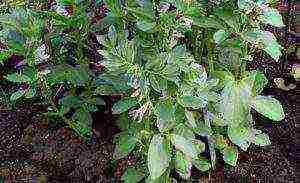
Some garden crops are grown for more than just the harvest. Planting beans on the site will help solve several problems at the same time. They will provide the family with healthy vegetables with a rich composition and high nutritional value, enrich the soil with nitrogen and make it looser.
Their highly branched roots, forming real dense thickets under the ground, interfere with the development of weeds and reliably protect the surface fertile soil layer from being washed out by rains. Black Russian beans are surprisingly unpretentious and require almost no maintenance.
Within 2 months after planting, each plant will bear 6-16 fruits, which can be cooked without resorting to peeling.
Site requirements
The beans will demonstrate the highest productivity on fertile loose loamy soils, which are characterized by a neutral or slightly alkaline reaction. But even in a soil poor in nutrients, they can successfully grow and bear fruit.
For full development, beans need potassium.If this element is not enough in the ground, you will have to artificially introduce it before planting. Professionals advise fertilizing the beds with wood ash or organic compounds.
Plants will need a lot of light, so you need to choose the sunniest area for them in the garden. Cold and too wet sandy soil is absolutely not suitable for beans.
The seeds sown in it most likely will not germinate, but will simply rot.
An ideal place for plants is a small hill, which is well warmed by the sun, freed from snow early and from which water flows down during heavy rains.
Beans react poorly to an excess of nitrogen in the soil. Observance of crop rotation is very important for this culture. You can not make beds for plants in areas where their relatives in the family were located last season: beans, peas, soybeans, chickpeas, lentils, peanuts. The soil suits them after growing the following crops:
- potatoes;
- tomatoes;
- cucumbers;
- pumpkins;
- cabbage.
But in the place vacated after their harvesting, all crops will develop well, except for legumes.
Landing dates
The beans are propagated by seeds. They are large in size, so there is no need to thoroughly prepare the soil for planting them.
They can be sown in open ground already at the beginning of April, when the snow will melt from the site and the earth will dry out slightly. They are not afraid of spring frosts: the planting material can easily withstand temperatures as low as -4 ° C.
In order for the seeds to germinate together, the soil must be warmed up to at least 5 ° C.
In regions with cold climates, the cultivation of beans through seedlings is practiced. In this case, they are sown in separate containers. The procedure is carried out 30-35 days before the planned date of planting plants in the beds (usually mid-May). This method is also used when you want to eat the harvest faster. Before placing the seedlings on a permanent site, they are hardened.
Advice
If you plant the seeds in stages, every month, properly caring for the sprouts, it will be possible to harvest the beans from the beans until the fall.
Sowing is carried out in 2 ways:
- on a flat area, leaving 40 cm of free space between the seeds;
- on the beds, reducing the distance between adjacent beans to 20-25 cm for dwarf varieties and up to 10-12 cm for tall ones.
The row spacings are made wide - not less than 45 cm. Most often, the beans are planted in 2 rows. This way the plants will bear more fruit and it will be easier to care for them. If black Russian beans are selected for breeding, the row spacing is reduced to 30 cm, and the seeds are laid out with a small interval - about 3-5 cm. It is better to plant them down with a scar: this way the seedlings will appear faster.
Sowing is carried out in moist soil. It will not be superfluous to water the beds after it ends. The planting material is preliminarily prepared by placing the seeds in water (for 5-6 hours) or in a growth stimulator (for 2-4 hours). You can wet a piece of cloth and wrap them in it so that they hatch.
The depth to which the beans are buried depends on the quality of the soil. If it is light, the seed hole is made 6-7 centimeters long. If it is heavy, 3-5 cm will be enough. Having dug in the seeds, mulch the surface of the garden. It will take 14 to 20 days for the young beans to emerge from the ground.
After that, the main task is to provide competent care for the plantings.
The subtleties of agricultural technology
Outdoors, the beans don't have to pay much attention. They belong to drought-resistant crops, but if it has not rained for a long time, the plantings need to be watered. They do this twice a week, spending at least 10 liters of water per square meter.
It is very important to regularly carry out care in the form of moisturizing at the stage of budding, flowering and ovary formation. Lack of water during this period will significantly reduce the yield of plants.
Their flowers will begin to wither and fall off, the same fate may befall the already formed pods.
Excess moisture is also harmful to beans, especially in the early stages of their development.Seedlings will actively increase the green mass, but they will not please with abundant flowering. Fruits on plants are set at a temperature of 20-22 ° C.
In hotter weather, when the air heats up to 25 ° C and above, you may not expect a good harvest. Frequent feeding of the beans is not required. At the germination stage, they are fed with mullein (0.5 l) and urea (1 tbsp. L).
Both fertilizers are thoroughly mixed in 10 liters of water. The resulting solution is poured over the plantings, spending 0.5 liters of the nutrient mixture for each bush. Further care includes feeding with herbal infusion diluted 1:10 or 1:15. It is carried out once a season, choosing the time after weeding for the procedure.
Tall beans are tied up to make it easier to care for them. The easiest way is to install a trellis for them. They do it like this:
- after planting, support stakes are driven into the soil at the edges of the rows. Their height should be 1-1.2 m;
- when the seedlings grow a little, a wire is pulled over the stakes with an interval of 30 cm.
Growing secrets
To grow beans more successful, regular soil loosening is carried out. In the spring, while the seedlings are still small, it is recommended to spud them with a hoe. The culture does not like the neighborhood of weeds, so the beds must be kept clean.
When the plants are covered with flowers, the upper part of their stems is pinched, shortening by 10-15 cm. The tender and juicy shoots lure the black bean aphid, for which they are a favorite delicacy. Getting rid of this pest will not be easy. Pinching also affects the ripening of the fruit, making it more even.
The first crop of beans outdoors can be harvested in early summer. It is important not to be late with the dates, otherwise the fruits will overripe, becoming slightly edible - fibrous and tough. You can eat beans of milk ripeness, which have reached a length of 10-15 cm.
In fully finished fruits, seeds are visible through the valves. First of all, the lower beans are removed from the bush, and the rest are harvested as they ripen. If the leaves are already blackened, it is better to leave the fruit on the plant so that later you can get seeds from it for planting.
Black Russian beans have a long history of cultivation. They were an important part of the diet of our ancestors, who appreciated this vegetable crop for its simplicity of agricultural technology and health benefits.
When eating bean dishes, the feeling of satiety remains for a long time, they saturate the body with the vitamins, minerals and trace elements it needs.
They are also used in folk medicine, providing anti-inflammatory, astringent and diuretic effects.
Plants are not afraid of heat and cold, and the presence of a powerful root system and a massive stem does not allow them to break under the weight of the crop or strong wind. Beans are the perfect fertilizer.
Throughout their life cycle, they will enrich the soil with nitrogen. And when it is completed, the bushes can be pulled out of the ground and buried during the autumn work on the site.
The stem and leaves of the beans will quickly decompose, saturating the soil with nutrients.
How to grow beans in the country? The basics of caring for beans: pinching, watering, loosening and feeding!
How to grow beans in the country? The basics of caring for beans: pinching, watering, loosening and feeding!
Hello my dear. Continuing the legumes theme. Today I will talk about favorable conditions for growing beans, watering regime, loosening and feeding. You will get acquainted with the basic rules of care and learn how pinching is useful to increase their yield.
To grow beans on your square meters, you do not need to have special knowledge, but still this process has its own nuances. This crop is of particular value as a green fertilizer and a natural source of proteins.
Thanks to the beans, the physical, biological, and chemical properties of soils are improved. The effect on the land of this green manure can be equated to the effect of manure.
Favorable growing conditions.
The most basic favorable conditions for growing include the condition of the land and plant nutrition. Irrigation mode and soil loosening.
An important factor is pinching, which will help increase the yield and reduce the number of pests.
State land for growth
Our plant is a long day. For its cultivation, plots are suitable, which are the first to be freed from snow in the spring.
Growing up in the country
- The best option for a crop is soil with slightly acidic or neutral reaction, high organic content and high moisture capacity.
- IN acidic soils they do not grow well. Light sandy soils are suitable if fertilizers have been previously applied to them and there is no subsoil that easily allows water to pass through, since stagnant water is detrimental to the plant.
- In areas poor soils organic matter, beans act as a green fertilizer. They are rich in nitrogen, which remains in the ground at about 5 g per 1 m² after harvesting plants from the site.
Therefore, it is very useful to grow beans in your summer cottage, thereby increasing the fertile properties and quality of the land for future plantings.
Germination temperature
It is a cold-hardy crop, so seeds in unprotected open ground begin to germinate at a minimum of 2 ° C. Seedlings survive frosts well down to -4 ° C.
The suitable temperature for flowering and fruiting is 15-20 ° C.
Began to curse
One of the conditions for obtaining a bountiful harvest is compliance with crop rotation. It is recommended to plant them in places where row crops (cabbage, potatoes and others) previously grew.
It is best to plant black beans in a separate bed, but can be combined with other plants. In general, it is better to change the planting sites of different crops.
How do you care for your beans?
Beans are a plant that is undemanding to special care conditions. Cultivation of culture is an interesting process that requires certain knowledge and skills.
Therefore, in order to obtain a bountiful harvest, it is necessary to carry out the basic care measures: feeding with nutrients, watering, pinching and loosening the soil. I will tell you about these conditions in detail.
Watering
Plants love moisture. They cannot withstand droughts, even for a short time. For swelling and germination, seeds need 100-120% moisture by their own weight. The best yields are obtained in years when it often rains from sprout to flowering.
If there is not enough rainfall, you need to water the beans more often. Watering plantings should be done every 3-4 days.
The optimal water consumption is 10 liters per 1 m². If the soil and air are dry, the number of fruit set will decrease and the ovaries will fall off. Therefore, pay attention to the amount of moisture in the garden and the amount of precipitation.
Top dressing
If your plantings do not grow well, they must be abundantly fed with fertilizers. They are given during the first two inter-row treatments.
- As a rule, dry dressings are used ammonium nitrate, potassium salt and superphosphate dry.
- If you apply top dressing in liquid form, the concentration of the solution should be 3%, that is, 3 g of fertilizer per 1 liter of water.
Growing fast
After this event, you need to water the beds abundantly so that the nutrients are fully utilized by the plants. If your beans grow well, you can do without feeding.
Soil treatment
If the sowing work was carried out in dry weather, after the sowing work, the soil must be rolled up. Three to four days after planting the seeds, harrowing should be carried out, which will prevent the formation of a soil crust and help in weed control.
After emergence, this technique should be repeated when they are in the phase of two leaves and a week after the first. A favorable time for this event is the afternoon.
Harrow immediately after planting and one week after planting. Harrowing along the sprouts is necessary across or at an angle.
Loosening before planting
During the growing season, two are usually carried out between row loosening, the third, if necessary: the first - to a depth of 12 cm, the second - to 8 cm.When this procedure is repeated, the plants are spilled for the second and third time.
Topping
When the beans are formed, the tops of the plants with leaves should be removed, which will greatly accelerate the growth of the fruit.
Also, this agrotechnical technique prevents the appearance of aphids, since, first of all, it populates the delicate tops of plants. And it will feast on our fruits. Aphids are carried by ants, so you need to pay attention to whether there are anthills nearby.
First flowers
The pinching itself has a beneficial effect on the growth and formation of pods and increases the yield of the beans. And if you are interested in a question about peas, then read my article on growing and caring for peas.
Perhaps they can also be grown at home. But I prefer to practice at my dacha and feast on real Russian black fruits.
- There are also different types of this culture. For example, hyacinth and soybeans, cocoa beans, which are also loved by many. You can read books about the cultivation of these interesting crops. I haven’t come up with these species yet.
That's all. Now you know what the technology of growing beans is. What lands are best suited for planting crops. What is their care, and what is the importance of pinching for growth and a good harvest.
On this I will end today. I still have a lot to do today. You need to send the first training homework, read, practice speed reading. Think about the strategic development of your blog.
: 5 out of 5 (2 votes)
Growing beans: a scientific approach and country tricks
Agree, it's boring to grow only potatoes, cucumbers and tomatoes in the country. You always want a rich variety so that you have something to surprise your household and guests. Some summer residents are not afraid even of capricious exotic plants. So why not grow unpretentious beans on the site? Let's figure out how to grow beans for high yields.
What is this vegetable?
To begin with, briefly about what beans are good for and what role they play in our diet.
Vegetable beans, despite a long history of cultivation, are not grown on an industrial scale due to the difficulties in mechanizing certain processes. This crop is for private gardening.
Bean is a fruit (pod) rich in protein, amino acids, iron, phosphorus, potassium and vitamins and has a high energy value with excellent taste. They eat unripe pods and seeds at the stage of milky and waxy ripeness.
However, it must be remembered that eating them without heat treatment, like pea grains, is not recommended due to their high toxicity and the risk of developing food poisoning. However, they are excellent in preservation and hot side dishes and sauces.
In addition, beans, like other members of the family, improve the structure of the soil, cleanse the area of weeds and enrich it with nitrogen.
In vegetable growing, varieties with different colors (from snow-white to dark purple), shapes and sizes of seeds are used. If you are interested in such a crop as vegetable beans, then its cultivation according to our recommendations will certainly be successful.
What Vegetable Beans Love
Being a crop with low requirements for soil types and levels of fertility, beans are still responsive to attention and, with high agricultural technology, give a good harvest.
They prefer loose, air-permeable nutrient soils with a neutral solution reaction.
They are especially sensitive to the content of potassium and, with its lack, growth is inhibited, therefore, experienced gardeners are advised to add wood ash to the garden before planting. The worst option for sowing is heavy acidic clay soils.
Vegetable corn, cucumber, cabbage, pumpkin, squash and potatoes are ideal precursors.
Vegetable beans are cold-resistant and moisture-loving plants. Seeds germinate at a temperature of 3-4 degrees, and spring frosts are not afraid of seedlings.
To start the development of the embryo and the emergence of a sprout, a lot of water is required (it is better to sow with swollen or germinated seeds in moist soil), this need persists until flowering.
Drought can cause buds to drop and even set fruits. However, water stagnation and waterlogging should not be allowed.
Planting beans should be done in warm, sunny areas.
How and when to prepare the soil in the garden
Since the sowing of beans is carried out in early spring, the preparation of the site must be started in the fall. After freeing from the predecessor, the bed is fertilized with organic matter and dug up. In the spring, it is enough to add superphosphate and potassium salt. The cultivation of legumes is carried out without nitrogen fertilizers, and only on poor soils it is advisable to introduce ammonium nitrate.
It is strictly forbidden to apply fresh manure and use increased doses of organic fertilizers. Excess nitrogen inhibits the development of nodule bacteria.
Presowing seed preparation
Bean seeds need to be soaked and processed before planting.
It is enough to soak the purchased certified seeds for 5 hours in water at room temperature, warm them up for 3 hours on a battery (using a thick cloth) and treat them with bacterial fertilizer Nitragin for beans (specialized strains of nodule bacteria are produced for each plant species of the family).
Seeds obtained at their summer cottage require more thorough preparation. After storage, they should be kept in a warm place for a day (for example, next to a heating battery or heater) so that caryopses (bruchus) beetles get out of the seeds in case of infection.
Soaking in water can be combined with a growth stimulant treatment to accelerate germination. To protect against diseases, the seeds are treated with a universal dressing agent approved for use in private household plots, according to the instructions.
After etching, it can be treated with Nitragin, this should be done on the day of sowing.
It is advisable to wait for the seeds to hatch before planting the beans in open ground. To do this, they are wrapped in damp gauze and left in a warm place without direct sunlight, moisturizing if necessary.
Direct sowing in open ground
Each region has its own timing when planting beans is best. General recommendations are as follows: sufficient soil temperature (4 - 5 degrees) and a good supply of moisture in the soil.
In the Middle Lane, the optimal sowing conditions are in late April - early May.
It is undesirable to delay sowing, since seeds need a lot of moisture for germination, and the soil saturated with melt water dries quickly on dry spring days.
There is another factor of early planting - the ability to avoid massive damage by the main pests of legumes - the moth, bruchus (weevil), weevils and pea aphids.
Some summer residents advise, when growing beans, planting in several stages with an interval of 10 days.
This technique allows you to extend the period of fruit consumption in the phase of milk ripeness, but a good result can be obtained only in regions with sufficient moisture or subject to regular irrigation.
Sowing is carried out according to two schemes: one-line with an interval between lines from 45 to 60 cm (the minimum value for dwarf varieties, and the maximum for tall ones) and a two-line ribbon with an interval between lines of 20 cm and between strips of 55 cm. The distance between plants in a row is 10 - 15 cm.On a site with structured light soil, the seeds are buried by 7 cm, and on heavy soils, 5 cm is enough.
Sowing is carried out with a scar down, since it is in this place that the first root will appear.Seedlings appear in 1 - 2 weeks, depending on the seedbed preparation.
Given the size of the seeds, perfect bed alignment is not required. The main thing is that planting and caring for plants in the future are as comfortable as possible.
For this, it is not recommended to make a bed that is too wide or too long. And you also need to plan conditions for frequent watering.
Seedling growing
Now let's talk about how to plant beans through seedlings. This method is relevant in the northern regions and in years with a protracted spring (when the soil does not dry out for a long time for harrowing).
Seeds are sown in early April in separate containers or peat pots one at a time (if the seeds are germinated). Until mid-May, the seedlings are kept at home and, after hardening, are planted in open ground.
Seedlings are not capricious to the temperature regime, but require good lighting and regular watering.
Features of caring for bean beds
If you already have experience in pea cultivation, then growing and caring for beans will not cause difficulties due to the similarity in agricultural technology.
As noted above, they belong to moisture-loving plants, but during the period of fruiting and ripening, watering should be reduced, especially with sufficient precipitation. In general, beans in the country grow "independently", without unnecessary care.
However, like any cultivated plant, they require some maintenance. Here are the key points for successful growing:
- nodule bacteria for their vital activity need an active access of oxygen, so one should not forget about loosening after each watering;
- waterlogging (especially on heavy soils) leads to the development of root rot;
- thickened plantings are most often affected by false and true powdery mildew;
- timely removal of weeds plays an important role in creating a healthy phytosanitary environment;
- tall varieties are recommended to be tied to a trellis, which can be made from wooden stakes and medium-thick wire;
- during the period of mass flowering, the upper shoot is pinched by 10 cm (this measure reduces the likelihood of aphid colonization and makes the fruit ripening evenly);
- it is enough to carry out one feeding with an infusion of chicken droppings during the period of active growth;
- the yield of beans will be higher if the harvesting of fruits is carried out in several stages as they reach the stage of milk ripeness, its maximum value can be 0.5 - 1.5 kg per 1 sq. meter (largely depends on the variety and air temperature during the flowering period).
These simple recommendations on how to grow beans in your summer cottage can be performed even by novice gardeners.
Even after harvesting, the bushes of vegetable beans can be useful for your summer cottage: the tops, cut at the base, will be an excellent green fertilizer for other vegetable crops, and the powerful, highly branched roots with nodules left in the soil will improve the structure and enrich the substrate with nitrogen.


